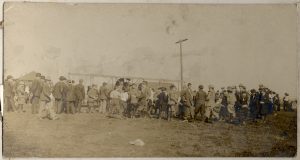Clarence H. Walker
 During May, 1911, Dexter P. Dorgan of the Continental Aviation Company, San Francisco, arrived in Honolulu to arrange flight demonstrations by pilots Clarence H. Walker and Didier Masson. A young millionaire, Walker originally took up flying as a pastime. He built his own airplane at Salt Lake City but, unable to make it fly, decided to take bona fide flying lessons then buy an airplane of standard construction. Purchasing a Curtiss biplane (60 hp) for $6,500,
During May, 1911, Dexter P. Dorgan of the Continental Aviation Company, San Francisco, arrived in Honolulu to arrange flight demonstrations by pilots Clarence H. Walker and Didier Masson. A young millionaire, Walker originally took up flying as a pastime. He built his own airplane at Salt Lake City but, unable to make it fly, decided to take bona fide flying lessons then buy an airplane of standard construction. Purchasing a Curtiss biplane (60 hp) for $6,500,
Walker found it profitable to go into the flying business. He teamed up with Dorgan and French aviator Masson then proceeded to Hawaii, first stop of a tour to include several cities in Australia. Hilo’s Hawaii Herald of June 8, 1911, reported: “First recognition came through his winning prize for amateurs at the big meeting given at the Tanforan race track, San Francisco, in January. After that he made flights throughout California and on May Day in Watsonville he covered 20 miles without a mishap of any kind.”
Walker and Masson arrived in Honolulu on June 3. The former’s biplane was on board, so was the new Mrs. Walker. Four days later, Walker, his wife and Mr. N. C. Adossides, president of the Continental Aviation Company, were in Hilo, Hawaii. They met with the local promoter, Mr. Felix Brughelli, and made arrangements for flight demonstrations out of Honolulu Park, a horseracing facility in Hilo.
Walker inspected the track to check for flight suitability. He found the enclosure too small for easy take-offs but indicated a willingness to make a flight from the grounds if a purse of $500 was offered. Two days were agreed upon, Saturday, June 10 and the following day. The Hilo Railway set up a special schedule for the two days to handle the expected large crowds. Brughelli began selling subscriptions and found eager response from Hilo residents.
On Saturday, Walker and his group arrived at Honolulu. The flyer made several test flights prior to public demonstrations, thus giving Big Islanders their first view of an airplane in action. The paying crowd which had gathered was disappointingly small; most of the local people were planning on Sunday for the aerial show.
The aviator got ready. Mrs. Walker stood by proudly as her husband started the engine and bumped along the grassy field to a quick take-off. The biplane rose rapidly amidst enthusiastic cheers. “From the beginning the eight cylinder engine was heard to misfire, the plane’s wings tipping from side to side. He flew to the edge of the ocean about two miles from the field then decided that a quick landing was the next order of activity. Walker said later, “I thought of landing in the ocean and then on the beach, but the water looked too deep and the beach was too full of boulders.”
The flyer headed back to the field with his unsteady, coughing airplane. Then on the eave of a smooth landing, a gust of wind caught and dashed the airplane into a 25-foot high lauhala tree. Four or five of the boys perched atop the tall tree was knocked to the ground. The tall tree’s outstretched branches served to soften the plane’s fall and the craft impacted the ground in sections.
The spunky pilot emerged from the wreckage and climbed onto the race track fence to show crowds, including his wife, that he was unhurt. This dramatic gesture was marred somewhat when fence boards gave way, sending Walker reeling unceremoniously to the ground. The atmosphere further lightened when Walker unleashed a verbal tirade about the airplane manufacturers and bemoaned his loss of $6,500. Repairs to his wrecked biplane were arranged with Hilo mechanics and the young couple boarded an interisland ship for Honolulu to join Masson and the others.
The Hawaii Herald’s June 15 edition carried the aviation story on its front page. It stated that spectators got their money’s worth, seeing the airplane fly “but also had a chance to realize the danger of the sport, when Aviator Walker’s biplane came to a sudden stop in the branches of a lauhala tree.” Walker received $1,250, the contracted fee, and the promoter lost approximately $1,000 due to one day’s demonstrations having to be cancelled.
Excerpted from the book Above the Pacific by Lieutenant Colonel William Joseph Horvat, 1966.
Photo Reference
- Clarence H. Walker Collection, NASM.2004.0056, National Air and Space Museum, Smithsonian Institution. https://airandspace.si.edu/collection-archive/clarence-h-walker-collection/sova-nasm-2004-0056